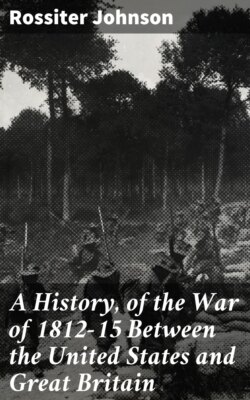A History, of the War of 1812-15 Between the United States and Great Britain

Реклама. ООО «ЛитРес», ИНН: 7719571260.
Оглавление
Rossiter Johnson. A History, of the War of 1812-15 Between the United States and Great Britain
A History, of the War of 1812-15 Between the United States and Great Britain
Table of Contents
DETAILED CONTENTS
A HISTORY OF THE WAR OF 1812–15
CHAPTER I.—CAUSES OF THE WAR
CHAPTER II. THE DETROIT CAMPAIGN
CHAPTER III. FIGHTS WITH THE INDIANS
CHAPTER IV. THE 'BATTLE OF QUEENSTOWN
CHAPTER V. WAR ON THE OCEAN
CHAPTER VI. MINOR BATTLES IN THE WEST
CHAPTER VII. WAR ON THE LAKES
CHAPTER VIII. BATTLE OF THE THAMES
CHAPTER IX. WILKINSON'S EXPEDITION
CHAPTER X. WAR IN THE SOUTH
CHAPTER XI. NAVAL BATTLES OF 1813
CHAPTER XII. PRIVATEERS
CHAPTER XIII. PEACE NEGOTIATIONS.—CAMPAIGN AGAINST THE CREEKS
CHAPTER XIV. BROWN'S CAMPAIGN ON THE NIAGARA
CHAPTER XV. THE SECOND INVASION OF NEW YORK
CHAPTER XVI. OPERATIONS ALONG THE COAST
CHAPTER XVII. THE WASHINGTON CAMPAIGN
CHAPTER XVIII. NAVAL BATTLES OF 1814
CHAPTER XIX. THE HARTFORD CONVENTION
CHAPTER XX. THE CAMPAIGN ON THE GULF COAST
CHAPTER XXI. PEACE
INDEX
Отрывок из книги
Rossiter Johnson
Published by Good Press, 2019
.....
Fort Madison, which had been built in an exposed and badly chosen situation on the bank of the Mississippi, near the site of St. Louis, was attacked on the 5th of September by more than two hundred Indians, Winnebagos. They approached stealthily, caught one of the garrison outside of the fort, and shot and scalped him within sight of his comrades on the walls. Firing was kept up on both sides for two days, but with little effect. On the 7th the savages displayed on poles the head and heart of the man they had killed, and later in the day tried to destroy the buildings by shooting upon the roofs arrows to which they had tied combustible matter and set it on fire. As at Fort Harrison, the appearance of fire created a panic among the men; but the commander, Lieutenant Hamilton, was equal to the occasion. He ordered eight old gun-barrels to be made into syringes, and small holes to be broken through the roof from the inside. Thrusting up the syringes through these holes, the men were able in a few minutes to make the roof as wet as if a heavy shower had fallen, which completely baffled the design of the enemy. On the 8th the Indians took possession of an old stable near the fort, and renewed the fight; but a few cannon-shot were sent crashing through the stable, while the gun-barrel syringes did duty as before, and the savages then withdrew.
Besides these actions at the forts, there were numerous encounters between small parties of white men and Indians, in which often great skill and courage were displayed. One of the most noteworthy was Colonel Ball's fight. That officer was descending the bank of Sandusky River with twenty-two mounted men, when a party of Indians about equal to their own numbers fired upon them from ambush. Ball and his men charged into the ambuscade, drove out the savages, and killed the chiefs. Ball was dismounted, and struggling with a gigantic chief, when one of his men came up and shot the Indian. The remaining Indians then became furious, and gave the signal for no quarter. Ball's men understood the situation, and fought without flinching, till they had killed every one of their antagonists. This affair had a wholesome effect upon the Indians of that region, and for some time the settlers were unmolested.
.....